Letermovir Primary Prophylaxis in High-Risk Hematopoietic Cell Transplant Recipients: A Matched Cohort Study
Abstract
1. Background
2. Methods
2.1. Design and Case-Control Matching
2.2. Study Hypothesis and Outcomes
2.3. Data Collection
2.4. Institutional Practices
2.5. Definitions
2.6. Healthcare Resource Utilization Variables
2.7. Statistical Analysis
3. Results
3.1. Patient Population
3.2. csCMV Infection
3.3. csCMV Infection Characteristics in Cases
3.4. CMVqPCR Results
3.5. CMV-Associated Treatment
3.6. Other Secondary Outcomes
3.7. Hematology and Laboratory Outcomes
4. Discussion
Supplementary Materials
Author Contributions
Funding
Institutional Review Board Statement
Informed Consent Statement
Data availability statement
Acknowledgments
Conflicts of Interest
Abbreviations
| CMV | cytomegalovirus |
| cs | clinically-significant |
| allo-HCT | allogeneic hematopoietic cell transplantation |
| LOS | length of stay |
| qPCR | quantitative polymerase-chain reaction |
| GvHD | graft-versus-host disease |
References
- Ljungman, P. The role of cytomegalovirus serostatus on outcome of hematopoietic stem cell transplantation. Curr. Opin. Hematol. 2014, 21, 466–469. [Google Scholar] [CrossRef] [PubMed]
- Robin, C.; Hémery, F.; Dindorf, C.; Thillard, J.; Cabanne, L.; Redjoul, R.; Beckerich, F.; Rodriguez, C.; Pautas, C.; Toma, A.; et al. Economic burden of preemptive treatment of CMV infection after allogeneic stem cell transplantation: A retrospective study of 208 consecutive patients. BMC Infect. Dis. 2017, 17, 1–8. [Google Scholar] [CrossRef] [PubMed]
- Boeckh, M.; Nichols, W.; Papanicolaou, G.; Rubin, R.; Wingard, J.R.; Zaia, J. Cytomegalovirus in hematopoietic stem cell transplant recipients: Current status, known challenges, and future strategies. Biol. Blood Marrow Transplant. 2003, 9, 543–558. [Google Scholar] [CrossRef]
- Yong, M.K.; Ananda-Rajah, M.; Cameron, P.U.; Morrissey, C.O.; Spencer, A.; Ritchie, D.; Cheng, A.C.; Lewin, S.R.; Slavin, M. Cytomegalovirus Reactivation Is Associated with Increased Risk of Late-Onset Invasive Fungal Disease after Allogeneic Hematopoietic Stem Cell Transplantation: A Multicenter Study in the Current Era of Viral Load Monitoring. Biol. Blood Marrow Transplant. 2017, 23, 1961–1967. [Google Scholar] [CrossRef]
- Green, M.L.; Leisenring, W.; Xie, H.; Mast, T.C.; Cui, Y.; Sandmaier, B.M.; Sorror, M.L.; Goyal, S.; Özkök, S.; Yi, J.; et al. Cytomegalovirus viral load and mortality after haemopoietic stem cell transplantation in the era of pre-emptive therapy: A retrospective cohort study. Lancet Haematol. 2016, 3, e119–e127. [Google Scholar] [CrossRef]
- Tomblyn, M.; Chiller, T.; Einsele, H.; Gress, R.; Sepkowitz, K.; Storek, J.; Wingard, J.R.; Young, J.-A.H.; Boeckh, M.A. Guidelines for Preventing Infectious Complications among Hematopoietic Cell Transplantation Recipients: A Global Perspective. Biol. Blood Marrow Transplant. 2009, 15, 1143–1238. [Google Scholar] [CrossRef]
- Navarro, D.; Amat, P.; De La Cámara, R.; López, J.; Vázquez, L.; Serrano, D.; Nieto, J.; Rovira, M.; Piñana, J.L.; Giménez, E.; et al. Efficacy and Safety of a Preemptive Antiviral Therapy Strategy Based on Combined Virological and Immunological Monitoring for Active Cytomegalovirus Infection in Allogeneic Stem Cell Transplant Recipients. Open Forum Infect. Dis. 2016, 3, 107. [Google Scholar] [CrossRef]
- Fang, J.; Su, Y.; Zavras, P.D.; Raval, A.D.; Tang, Y.; Perales, M.-A.; Giralt, S.; Stern, A.; Papanicolaou, G.A. Impact of Preemptive Therapy for Cytomegalovirus on Hospitalizations and Cost after Hematopoietic Stem Cell Transplantation. Biol. Blood Marrow Transplant. 2020, 26. [Google Scholar] [CrossRef]
- Teira, P.; Battiwalla, M.; Ramanathan, M.; Barrett, A.J.; Ahn, K.W.; Chen, M.; Green, J.S.; Saad, A.; Antin, J.H.; Savani, B.N.; et al. Early cytomegalovirus reactivation remains associated with increased transplant-related mortality in the current era: A CIBMTR analysis. Blood 2016, 127, 2427–2438. [Google Scholar] [CrossRef]
- El Haddad, L.; Ghantoji, S.S.; Park, A.K.; Batista, M.V.; Schelfhout, J.; Hachem, J.; Lobo, Y.; Jiang, Y.; Rondon, G.; Champlin, R.; et al. Clinical and economic burden of pre-emptive therapy of cytomegalovirus infection in hospitalized allogeneic hematopoietic cell transplant recipients. J. Med. Virol. 2020, 92, 86–95. [Google Scholar] [CrossRef]
- Marty, F.M.; Ljungman, P.; Chemaly, R.F.; Maertens, J.; Dadwal, S.S.; Duarte, R.F.; Haider, S.; Ullmann, A.J.; Katayama, Y.; Brown, J.; et al. Letermovir Prophylaxis for Cytomegalovirus in Hematopoietic-Cell Transplantation. N. Engl. J. Med. 2017, 377, 2433–2444. [Google Scholar] [CrossRef]
- Lin, A.; Maloy, M.; Su, Y.; Bhatt, V.; DeRespiris, L.; Griffin, M.; Lau, C.; Proli, A.; Barker, J.; Shaffer, B.; et al. Letermovir for primary and secondary cytomegalovirus prevention in allogeneic hematopoietic cell transplant recipients: Real-world experience. Transpl. Infect. Dis. 2019, 21, e13187. [Google Scholar] [CrossRef]
- Anderson, A.; Raja, M.; Vazquez, N.; Morris, M.; Komanduri, K.; Camargo, J.F. Clinical “real-world” experience with letermovir for prevention of cytomegalovirus infection in allogeneic hematopoietic cell transplant recipients. Clin. Transplant. 2020, 34, e13866. [Google Scholar] [CrossRef] [PubMed]
- Studer, U.; Khanna, N.; Leuzinger, K.; Hirsch, H.H.; Heim, D.; Lengerke, C.; Tsakiris, D.A.; Halter, J.; Gerull, S.; Passweg, J.; et al. Incidence of CMV Replication and the Role of Letermovir Primary/Secondary Prophylaxis in the Early Phase After Allogeneic Hematopoietic Stem Cell Transplantation—A Single Centre Study. Anticancer Res. 2020, 40, 5909–5917. [Google Scholar] [CrossRef]
- Ljungman, P.; Griffiths, P.; Paya, C. Definitions of Cytomegalovirus Infection and Disease in Transplant Recipients. Clin. Infect. Dis. 2002, 34, 1094–1097. [Google Scholar] [CrossRef]
- Ljungman, P.; Boeckh, M.; Hirsch, H.H.; Josephson, F.; Lundgren, J.; Nichols, G.; Pikis, A.; Razonable, R.R.; Miller, V.; Griffiths, P.D. Definitions of Cytomegalovirus Infection and Disease in Transplant Patients for Use in Clinical Trials: Table 1. Clin. Infect. Dis. 2017, 64, 87–91. [Google Scholar] [CrossRef]
- Marty, F.M.; Ljungman, P.T.; Chemaly, R.F.; Wan, H.; Teal, V.L.; Butterton, J.R.; Yeh, W.W.; Leavitt, R.Y.; Badshah, C.S. Outcomes of patients with detectable CMV DNA at randomization in the phase III trial of letermovir for the prevention of CMV infection in allogeneic hematopoietic cell transplantation. Arab. Archaeol. Epigr. 2019, 20, 1703–1711. [Google Scholar] [CrossRef] [PubMed]
- Royston, L.; Royston, E.; Masouridi-Levrat, S.; Chalandon, Y.; Van Delden, C.; Neofytos, D. Predictors of Breakthrough Clin-ically-Significant Cytomegalovirus Infection during Letermovir Prophylaxis in High-Risk Hematopoietic Cell Transplant Recipients. Immun. Inflamm. Dis. 2021, in press. [Google Scholar]
- Nakamae, H.; Storer, B.; Sandmaier, B.M.; Maloney, D.G.; Davis, C.; Corey, L.; Storb, R.; Boeckh, M. Cytopenias after day 28 in allogeneic hematopoietic cell transplantation: Impact of recipient/donor factors, transplant conditions and myelotoxic drugs. Haematologica 2011, 96, 1838–1845. [Google Scholar] [CrossRef]
- Masouridi-Levrat, S.; Simonetta, F.; Chalandon, Y. Immunological Basis of Bone Marrow Failure after Allogeneic Hematopoietic Stem Cell Transplantation. Front. Immunol. 2016, 7, 362. [Google Scholar] [CrossRef]
- Zamora, D.; Duke, E.R.; Xie, H.; Edmison, B.C.; Akoto, B.B.; Kiener, R.; Stevens-Ayers, T.; Wagner, R.; Mielcarek, M.; Leisenring, W.M.; et al. Cytomegalovirus-specific T-cell Reconstitution following Letermovir Prophylaxis after Hematopoietic Cell Transplantation. Blood 2021. [Google Scholar] [CrossRef] [PubMed]
- Sperotto, A.; Candoni, A.; Gottardi, M.; Facchin, G.; Stella, R.; De Marchi, R.; Michelutti, A.; Cavallin, M.; Rosignoli, C.; Patriarca, F.; et al. Cytomegalovirus prophylaxis vs. pre-emptive strategy: Different cd4+ and cd8+ t-cell reconstitution after allogeneic hematopoietic stem cell transplantation. Transplant. Cell. Ther. 2021, in press. [Google Scholar] [CrossRef] [PubMed]
- Chen, G.L.; Wallace, P.K.; Zhang, Y.; Tario, J.D.; Przespolewski, A.C.; Becker, J.; Almyroudis, N.G.; Ross, M.; Riches, M.; Segal, B.H.; et al. Low-Level Cytomegalovirus Antigenemia Promotes Protective Cytomegalovirus Antigen-Specific T Cells after Allogeneic Hematopoietic Cell Transplantation. Biol. Blood Marrow Transplant. 2020, 26, 2147–2154. [Google Scholar] [CrossRef] [PubMed]
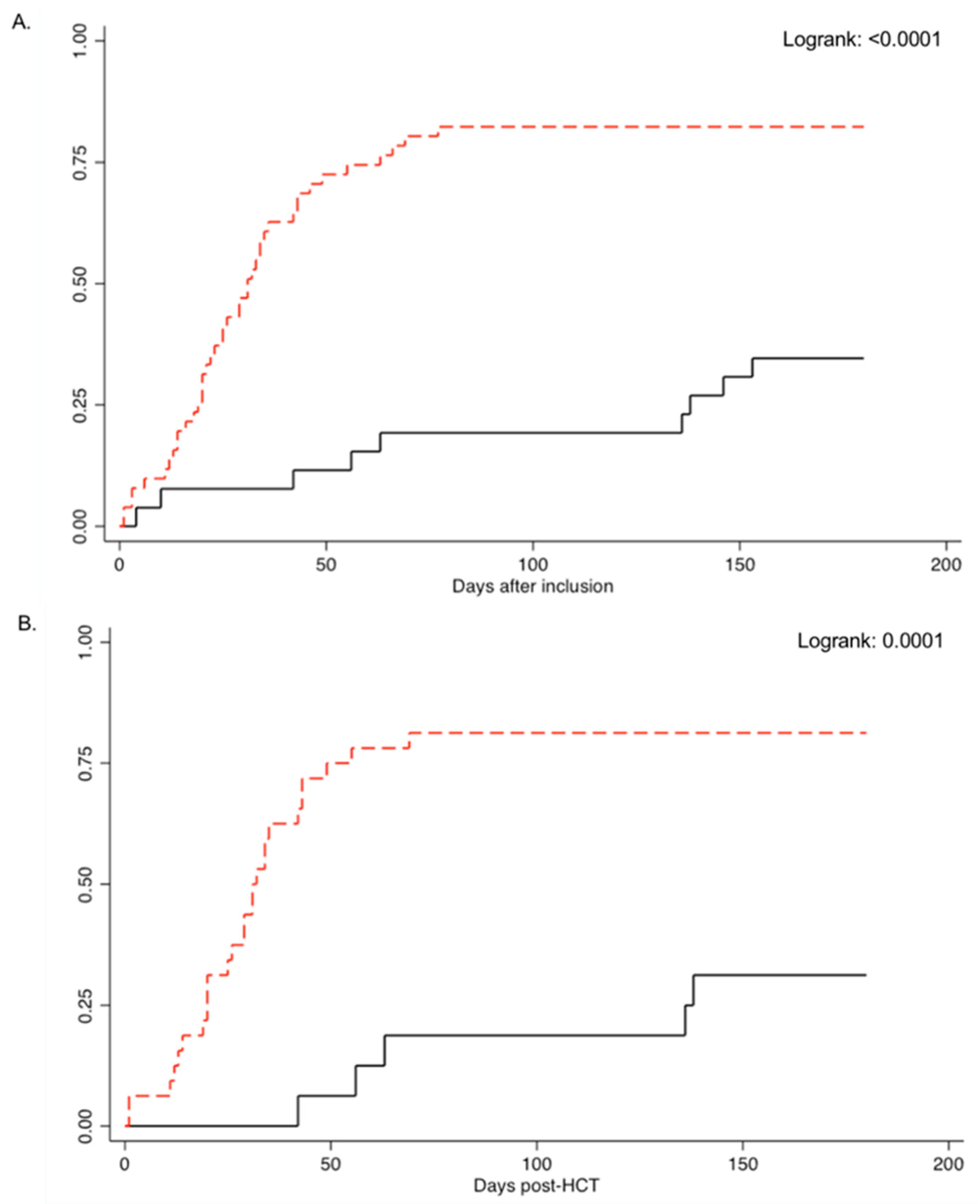
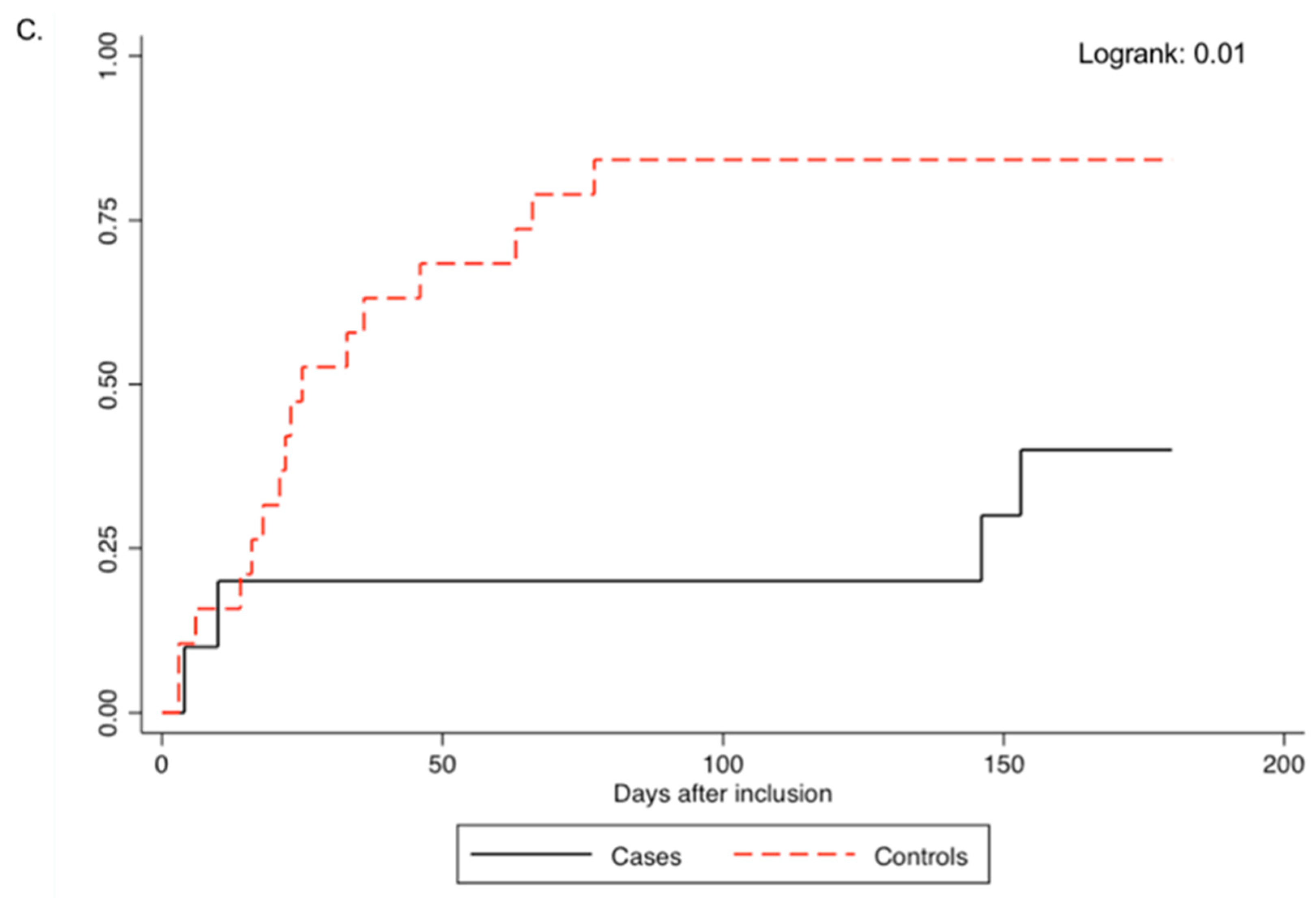
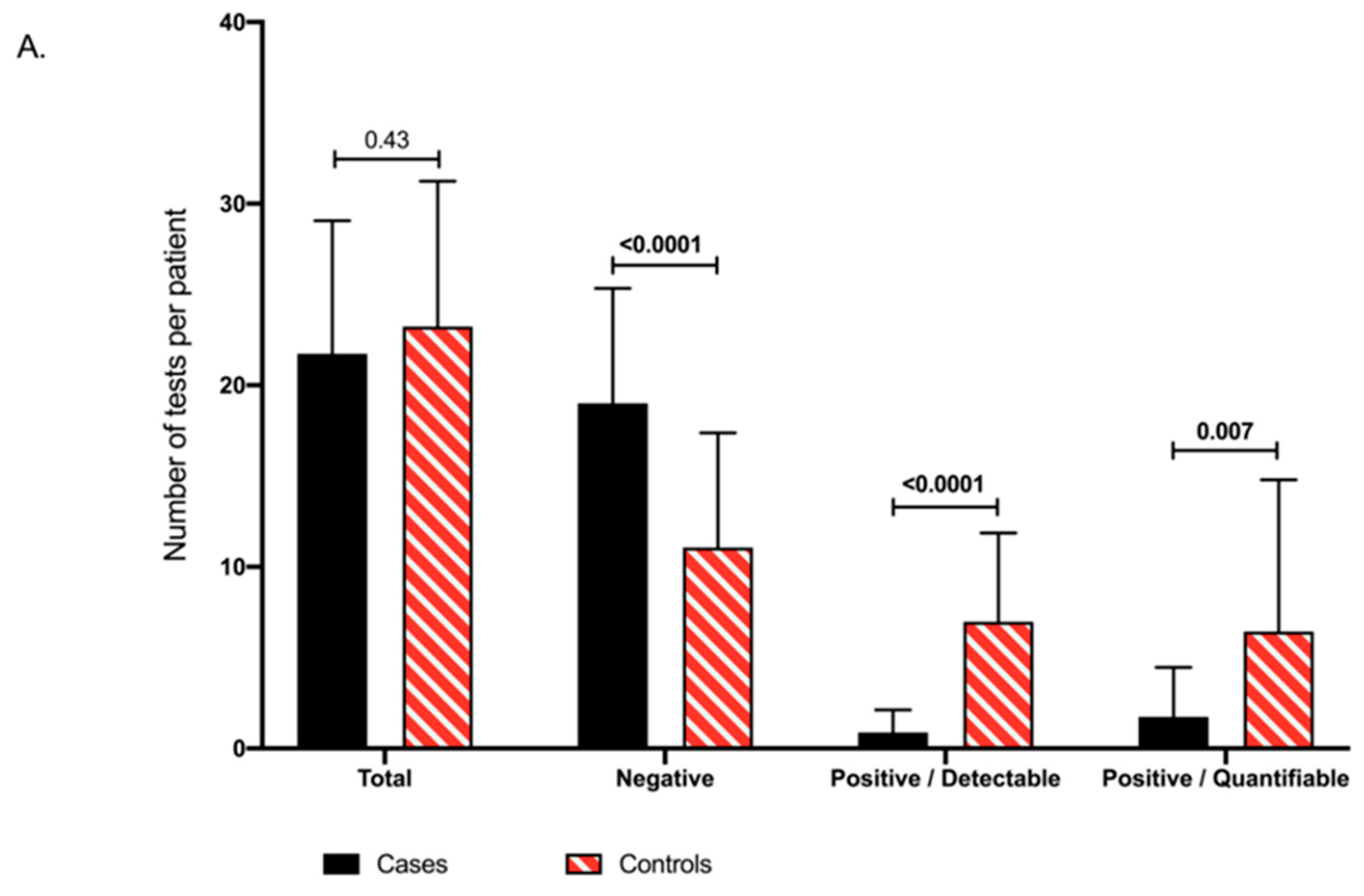
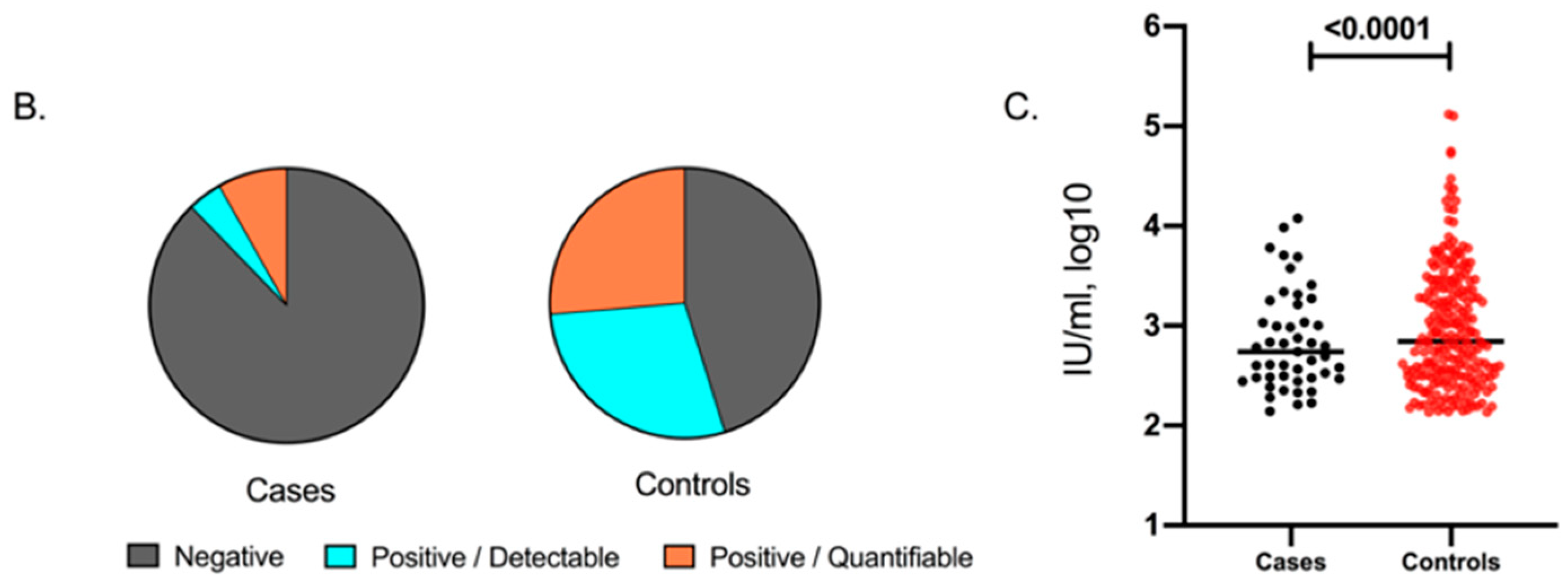
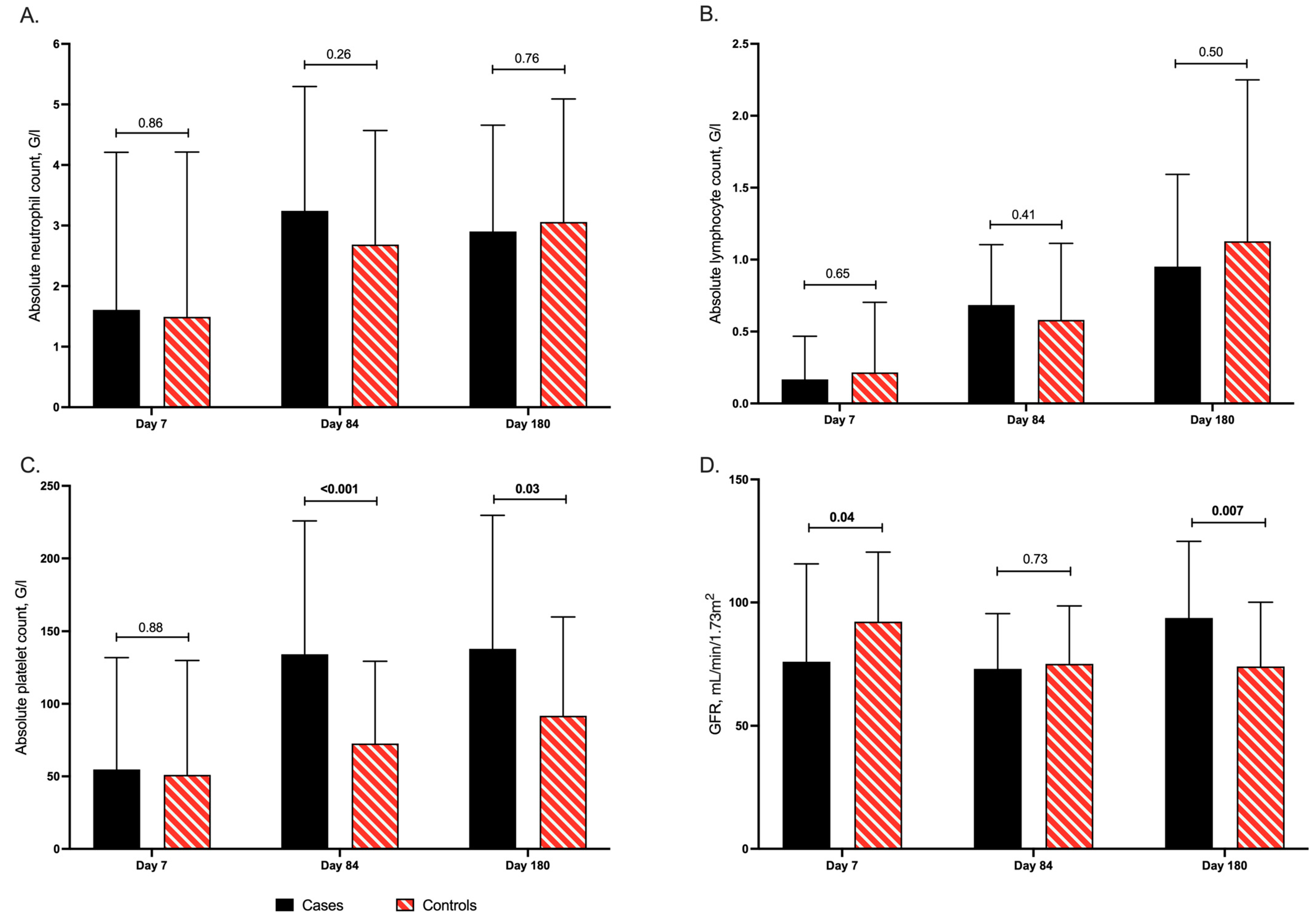
| Patient and HCT Characteristics | All Patients n = 78 (%) | Cases n = 26 (%) | Controls n = 52 (%) | p-Value |
|---|---|---|---|---|
| Demographics | ||||
| Age (Years), Mean (Range) | 55.3 (17, 74) | 55.8 (17, 73) | 55.0 (21, 74) | 0.81 |
| Gender, Female | 30 (38.5) | 9 (34.6) | 21 (40.4) | 0.81 |
| Underlying disease | ||||
| Myeloid hematologic malignancy | 56 (71.8) | 18 (69.2) | 38 (73.1) | 0.79 |
| Lymphoid hematologic malignancy | 22 (28.2) | 8 (30.8) | 14 (26.9) | |
| Malignancy remission before HCT | 67 (85.9) | 21 (80.8) | 46 (88.5) | 0.49 |
| HCT Characteristics | ||||
| Conditioning, Myeloablative | 19 (24.4) | 7 (26.9) | 12 (23.1) | 0.78 |
| HCT donor-recipient matching | 0.95 | |||
| HLA-matched related | 13 (16.7) | 4 (15.4) | 9 (17.3) | |
| HLA-matched unrelated | 42 (53.9) | 15 (57.7) | 27 (51.9) | |
| Haploidentical | 23 (29.5) | 7 (26.9) | 16 (30.8) | |
| HCT source | 0.53 | |||
| Bone marrow | 13 (16.7) | 3 (11.5) | 10 (19.2) | |
| Peripheral blood | 65 (83.3) | 23 (88.5) | 42 (80.8) | |
| GvHD 1 | ||||
| GvHD grade ≥ 2 | 30 (38.5) | 10 (38.5) | 20 (38.5) | 1.00 |
| Acute GvHD | 30 (38.5) | 10 (38.5) | 20 (38.5) | 1.00 |
| Refractory GvHD | 2 (2.6) | 1 (3.9) | 1 (1.9) | 1.00 |
| GIT GvHD | 22 (28.2) | 8 (30.8) | 14 (26.9) | 0.79 |
| Serologies | ||||
| CMV serological status | 1.00 | |||
| Donor+/Recipient+ | 27 (34.6) | 9 (34.6) | 18 (34.6) | |
| Donor−/Recipient+ | 51 (65.4) | 17 (65.4) | 34 (65.4) | |
| EBV serological status | 0.56 | |||
| Donor+/Recipient− | 4 (5.1) | 2 (7.7) | 2 (3.9) | |
| Donor+/Recipient+ | 68 (87.2) | 23 (88.5) | 45 (86.5) | |
| Donor−/Recipient+ | 6 (7.7) | 1 (3.9) | 5 (9.6) | |
| Toxoplasmosis serological status | 0.71 | |||
| Donor−/Recipient− | 22 (28.2) | 8 (30.8) | 14 (26.9) | |
| Donor+/Recipient− | 4 (5.1) | 1 (3.9) | 3 (5.8) | |
| Donor+/Recipient+ | 19 (24.4) | 8 (30.8) | 11 (21.2) | |
| Donor−/Recipient+ | 33 (42.3) | 9 (34.6) | 24 (46.2) | |
| csCMV infection prior to study inclusion | 3 (3.9) | 1 (3.9) | 2 (3.9) | 1.00 |
| Cases n: 26 (%) | Controls n: 52 (%) | p-Value | |
|---|---|---|---|
| Primary outcome 1 | |||
| csCMV infection 2 | 9 (34.6) | 43 (82.7) | <0.0001 |
| Secondary outcomes1 | |||
| >1 csCMV infection 3 | 3 (11.5) | 31 (59.6) | <0.0001 |
| CMV treatment duration4 | 49 (15, 104) | 77.8 (8, 155) | 0.02 |
| Ganciclovir | 24 (14, 34) | 24 (5, 67) | 1.00 |
| Valganciclovir | 27.3 (8, 70) | 57.1 (14, 142) | 0.008 |
| Foscarnet | 23.5 (5, 41) | 20.7 (4, 84) | 0.79 |
| Cidofovir | 22.3 (8, 31) | ||
| CMV treatment costs5 | 3758 (550, 10,115) | 8932 (770, 32,121) | 0.07 |
| Ganciclovir | 4155 (1545, 6465) | 3145 (71, 8188) | 0.60 |
| Valganciclovir | 999 (293, 2565) | 2093 (513, 5204) | 0.008 |
| Foscarnet | 5842 (1384, 9455) | 9454 (1614, 29,519) | 0.43 |
| Cidofovir | 4931 (2336, 6229) | ||
| Letermovir costs5 | 38,461 (1788, 89,193) | NA | |
| Length of stay6 | 44.8 (2, 109) | 59.8 (3, 180) | 0.16 |
| Readmission | 8 (30.8) | 17 (32.7) | 1.00 |
| >1 Readmission | 2 (7.7) | 6 (11.5) | 0.71 |
| Hospitalization costs7 | 115,025 (5136, 279,912) | 153,370 (7704, 462,240) | 0.16 |
| Total costs8 | 142,763 (3106, 348,957) | 151,849 (1356, 488,389) | 0.75 |
| All-cause 6-month mortality | 4 (15.4) | 13 (25.0) | 0.40 |
| Non-CMV viral infection9 | 12 (46.2) | 18 (34.6) | 0.34 |
| Herpes simplex virus 1/2 | 0 | 3 (5.8) | 0.55 |
| Epstein-Barr virus | 6 (23.1) | 5 (9.6) | 0.17 |
| Human herpes virus 6 | 1 (3.9) | 4 (7.7) | 0.66 |
| Adenovirus | 0 | 4 (7.7) | 0.30 |
| BK-virus | 5 (19.2) | 5 (9.6) | 0.29 |
| Variables | Univariable Analysis | Multivariable Analysis | ||||
|---|---|---|---|---|---|---|
| Odds Ratio | 95% CI | p-Value | Odds Ratio | 95% CI | p-Value | |
| Demographics | ||||||
| Age (Years), Mean (Range) | 1.01 | 0.98, 1.04 | 0.41 | |||
| Gender, Female vs. Male | 0.78 | 0.29, 2.08 | 0.62 | |||
| Underlying disease | ||||||
| Myeloid vs. Lymphoid hematologic malignancy | 1.10 | 0.38, 3.15 | 0.86 | |||
| Malignancy remission before HCT, Yes vs. No | 0.35 | 0.10, 1.30 | 0.12 | 0.39 | 0.09, 1.70 | 0.21 |
| HCT Characteristics | ||||||
| Conditioning, Non-Myeloablative vs. Myeloablative | 0.45 | 0.15, 1.30 | 0.14 | 0.47 | 0.13, 1.66 | 0.24 |
| HLA-matched related vs. HLA-matched unrelated vs. Haploidentical | 1.55 | 0.75, 3.17 | 0.23 | |||
| Bone marrow vs. Peripheral blood stem cells | 3.22 | 0.66, 15.77 | 0.15 | 2.44 | 0.38, 15.70 | 0.35 |
| GvHD grade ≥ 2 at baseline, Yes vs. No | 1.28 | 0.48, 3.41 | 0.62 | |||
| GvHD grade ≥2 post baseline, Yes vs. No | 2.22 | 0.72, 6.89 | 0.17 | |||
| Acute GvHD grade ≥ 2 at baseline, Yes vs. No | 1.28 | 0.48, 3.41 | 0.62 | |||
| Acute GvHD grade ≥2 post baseline, Yes vs. No | 1.87 | 0.60, 5.83 | 0.28 | |||
| Refractory GvHD at baseline, Yes vs. No | 0.49 | 0.03, 8.17 | 0.62 | |||
| GIT GvHD at baseline, Yes vs. No | 1.48 | 0.50, 4.39 | 0.48 | |||
| Serologies | ||||||
| CMV serological status, D + R+ vs. D-R+ | 0.77 | 0.28, 2.11 | 0.61 | |||
| EBV serological status | 1.17 | 0.44, 3.14 | 0.75 | |||
| Toxoplasmosis serological status | 1.08 | 0.71, 1.64 | 0.72 | |||
| Controls vs. Cases | 9.02 | 3.06, 26.61 | <0.0001 | 9.14 | 2.94, 28.3 | <0.0001 |
Publisher’s Note: MDPI stays neutral with regard to jurisdictional claims in published maps and institutional affiliations. |
© 2021 by the authors. Licensee MDPI, Basel, Switzerland. This article is an open access article distributed under the terms and conditions of the Creative Commons Attribution (CC BY) license (https://creativecommons.org/licenses/by/4.0/).
Share and Cite
Royston, L.; Royston, E.; Masouridi-Levrat, S.; Vernaz, N.; Chalandon, Y.; Van Delden, C.; Neofytos, D. Letermovir Primary Prophylaxis in High-Risk Hematopoietic Cell Transplant Recipients: A Matched Cohort Study. Vaccines 2021, 9, 372. https://doi.org/10.3390/vaccines9040372
Royston L, Royston E, Masouridi-Levrat S, Vernaz N, Chalandon Y, Van Delden C, Neofytos D. Letermovir Primary Prophylaxis in High-Risk Hematopoietic Cell Transplant Recipients: A Matched Cohort Study. Vaccines. 2021; 9(4):372. https://doi.org/10.3390/vaccines9040372
Chicago/Turabian StyleRoyston, Léna, Eva Royston, Stavroula Masouridi-Levrat, Nathalie Vernaz, Yves Chalandon, Christian Van Delden, and Dionysios Neofytos. 2021. "Letermovir Primary Prophylaxis in High-Risk Hematopoietic Cell Transplant Recipients: A Matched Cohort Study" Vaccines 9, no. 4: 372. https://doi.org/10.3390/vaccines9040372
APA StyleRoyston, L., Royston, E., Masouridi-Levrat, S., Vernaz, N., Chalandon, Y., Van Delden, C., & Neofytos, D. (2021). Letermovir Primary Prophylaxis in High-Risk Hematopoietic Cell Transplant Recipients: A Matched Cohort Study. Vaccines, 9(4), 372. https://doi.org/10.3390/vaccines9040372







